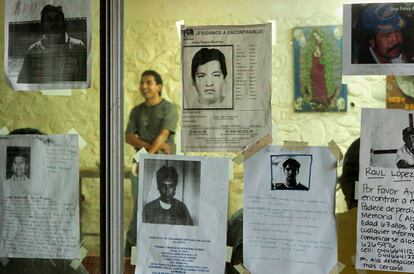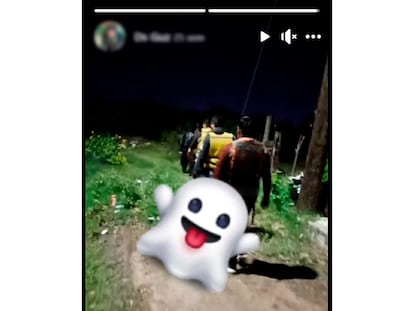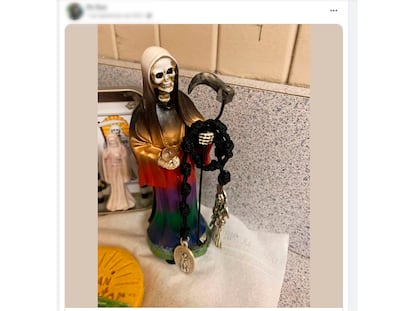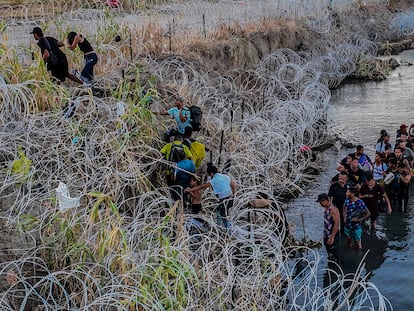Inside the Facebook profile of a migrant smuggler
Three members of the Northeast Cartel have pled guilty to human trafficking on the border between Mexico and the United States. The case has shone a light on how criminals recruit clients and victims via social media

El Gus is one of those people who share everything on social media. He posted about what he ate and who he was with. He sent loving messages to his girlfriend and posts support for his friends. He complained when there was a concert he wanted to go to, but couldn’t afford it. He professed his faith in Santa Muerte (the personification of death). He shared memes and motivational quotes and wrote about his professional achievements. He dreamed of having a lot of money.
“I am the indebted sheep of the family,” he wrote on his Facebook profile. “I know what it is to have and not have money, that’s why they don’t impress me with anything,” he posted. “Heading to work as a patero to earn some money,” he posted at the end of August. He did not try to hide the fact that he was a patero, as migrant smugglers are known on the border between Mexico and Texas.
Social media was a form of escapism. El Gus liked to pose wearing a border patrol cap. He posted stories in the checkpoints in Nuevo Laredo (Tamaulipas). He used an image of a border patrol vehicle as his Facebook cover photo. He recorded videos showing migrants walking in line, with life jackets on, in the middle of the night. “I don’t give a damn about them,” he said proudly and confidently, as reggaeton music played in the background, in a reel that can still be seen on his profile.

Social media was also a work tool. “Departure in camarote today at 3 and 5,” he posted on August 23, to announce that there were places available on the trips he was going to make from the border to other cities in the United States. A camarote is what pateros call the cabins where bus drivers sleep, but sometimes they also put migrants in box trailers.
It didn’t take long for him to find a client. At noon, he received a message from someone who knew of people who were interested. “How many?” asked El Gus. “Three,” they answered. The patero told the client that was fine, but gave them his phone number to close the deal via WhatsApp.
Minutes later, the client received the call. “I’m speaking to you on behalf of Don Gus,” a man told him. Later it turned out that it was actually Gus calling, but perhaps he wanted to protect himself or appear important. They struck a deal on the phone. The interested party was going to pay him $450 when they arrived in Laredo (Texas) and $7,800 more when they reached their final destination. Gus didn’t know he was talking to an undercover agent.
Under the agreement, three undocumented migrants would be picked up in the parking lot of a seafood restaurant, on one of the main avenues in Laredo. A Ford Raptor pickup truck was going to pass by to collect them. At the last minute, the undercover agent canceled the deal. But Gus was already in their sights. They knew that his real name was Luis Daniel Segura.
The Ford Raptor left the seafood restaurant and drove to an open field, which was less than two miles away. The agents identified the driver as Bernardo Garza, who made the stop to speak with two other men who belonged to the human trafficking network. From there, he went to a parking lot with several cargo trucks, parked next to a red tractor-trailer, opened the back door of the truck and let three migrants out, including a 15-year-old girl. The three were from Mexico and El Salvador and had agreed to pay thousands of dollars for the service.
The police intercepted Garza before he had time to take out the weapon he had in the Ford Raptor, and arrested him. Less than a month later, they tracked down Francisco Suárez, alias “Pancho,” who worked as a hawk — someone who makes sure that no one is following the traffickers — and told the drivers where the migrants were being held. On September 16, Luis Daniel Segura, “El Gus,” was killed in an operation near the southern border of Texas. When they searched his phone, the police connected the dots: they found his Facebook profile, conversations with Pancho, and messages he sent to the undercover agent.

Segura confessed that he had been recruited by the Northeast Cartel, a splinter of Los Zetas. At the end of October, the three were indicted by a grand jury on two counts of migrant smuggling, and may be sentenced to up to 10 years in prison and a fine of $250,000. One of the migrants was willing to testify against him. There were also dozens and dozens of social media posts that could be used as evidence.
Cornered, the three decided to plead guilty to one of the charges last week. None of them are over 30 years old. Garza is 26; Segura, 25, and Pancho, 19. The Prosecutor’s Office for the Southern District of Texas celebrated the confession, but also criticized social media for facilitating trafficking. “The cartels are increasing the use of social media as part of their illegal business model,” said U.S. attorney Alamdar Hamdani. “Applications, such as Facebook, allow these organizations to advertise human smuggling services to large audiences along the U.S. border,” he added.
Facebook did not respond to the attorney’s comments. “In an effort to disrupt and prevent harm, we remove content that facilitates or coordinates the exploitation of humans, including human trafficking,” the company states in its policy guidelines, last updated on January 12, which explicitly prohibit content that encourages or offers the exact services Northeast Cartel was posting about.
Breaking up migrant smuggling organizations was one of the top issued discussed at the ministerial meeting between Mexican and U.S. authorities in Washington last week. Ken Salazar, the U.S. ambassador to Mexico, reported on Monday that at least 10 such criminal groups had been dismantled. According to Salazaar, these networks operated in Honduras, Guatemala and El Salvador, as well as the Mexican states of Chiapas, Chihuahua, Hidalgo and Veracruz.
Salazar said that increased controls on northbound bus and train routes have led to a drop in migrant arrivals since December, and condemned criminal organizations for profiting from desperate migrants. Mexican Foreign Minister Alicia Bárcena said that the head of Security, Rosa Icela Rodríguez, and senior officials from the Attorney General’s Office will meet again with their American counterparts to strengthen the mechanisms against trafficking networks.

Illegal immigration has become one of the most controversial issues in the U.S. elections. Far-right politicians have been quick to turn the migrant crisis into a political weapon against the Joe Biden administration and the Mexican government of Andrés Manuel López Obrador.
“The only thing that we’re not doing is we’re not shooting people who come across the border, because of course, the Biden administration would charge us with murder,” Texas Governor Greg Abbott said in a radio interview on January 5. That statements sparked a wave of criticism against Abbott, who is known for his hard-line anti-immigration discourse. The Biden administration has taken Abbott’s government to court over its measures to curb immigration, which include setting up buoys to stop migrants crossing the Rio Grande, putting razor wire at the border and deploying armed guards.
The irony is these iron-fist policies, combined with the lack of legal immigration routes, help fuel criminal organizations, which are able to prey on desperate people who are willing to take unsafe routes and to pay more and more money for their services. Around the same time that Abbott erected the floating wall of buoys, El Gus shared photos of himself “playing tag” with border agents on social media. He even posted photos of the buoys. Between October 2022 and September 2023, when his criminal cell was dismantled, there were more than 2.5 million migrant arrests at the border.
Sign up for our weekly newsletter to get more English-language news coverage from EL PAÍS USA Edition
Tu suscripción se está usando en otro dispositivo
¿Quieres añadir otro usuario a tu suscripción?
Si continúas leyendo en este dispositivo, no se podrá leer en el otro.
FlechaTu suscripción se está usando en otro dispositivo y solo puedes acceder a EL PAÍS desde un dispositivo a la vez.
Si quieres compartir tu cuenta, cambia tu suscripción a la modalidad Premium, así podrás añadir otro usuario. Cada uno accederá con su propia cuenta de email, lo que os permitirá personalizar vuestra experiencia en EL PAÍS.
¿Tienes una suscripción de empresa? Accede aquí para contratar más cuentas.
En el caso de no saber quién está usando tu cuenta, te recomendamos cambiar tu contraseña aquí.
Si decides continuar compartiendo tu cuenta, este mensaje se mostrará en tu dispositivo y en el de la otra persona que está usando tu cuenta de forma indefinida, afectando a tu experiencia de lectura. Puedes consultar aquí los términos y condiciones de la suscripción digital.
More information
Archived In
Últimas noticias
Most viewed
- Pablo Escobar’s hippos: A serious environmental problem, 40 years on
- Why we lost the habit of sleeping in two segments and how that changed our sense of time
- Charles Dubouloz, mountaineering star, retires at 36 with a farewell tour inspired by Walter Bonatti
- Reinhard Genzel, Nobel laureate in physics: ‘One-minute videos will never give you the truth’
- The Florida Keys tourist paradise is besieged by immigration agents: ‘We’ve never seen anything like this’











































